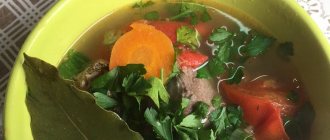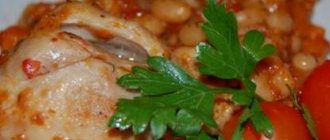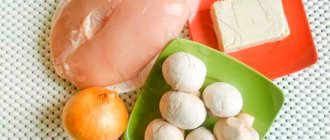Compared to animal meat, chicken is lower in calories, which is why it is included in many diets. Poultry meat is not uniform—a dry, fibrous breast has fewer calories than a juicy thigh. But it is this that many consider the most delicious part of the bird. The thigh is an enlarged part of the leg located above the lower leg. The meat adheres to a small bone and is relatively dark in color.
Calorie content
The calorie content of 100 g of raw chicken thigh is 185-211 kcal (depending on the fat content of the bird). To reduce this indicator, skin and fat should be removed from the product.
Poultry prepared in different ways has different caloric content per 100 g of product:
- raw thigh with skin – 185-211 kcal;
- raw thigh without skin – 150-170 kcal;
- boiled – 160 kcal;
- baked in the oven – 165 kcal;
- fried – 240-250 kcal;
- stew – 185 kcal.
Composition and beneficial properties
Proteins, fats and carbohydrates (BJU) of chicken thigh are balanced and acceptable for dietary nutrition. Per 100 grams of weight - 21.5 g of protein, 11 g of fat and a complete absence of carbohydrates. In addition, the product contains microelements necessary for our body: sodium, potassium, phosphorus, zinc, iron and vitamins: A, E, PP, group B.
A large amount of protein ensures the growth of muscle mass and rapid saturation of the body. Therefore, both athletes and lovers of various diets can include chicken meat in their diet.
The sodium contained in the hips is necessary to keep nutrients in a liquid state, which allows the blood to carry them to our organs. Without sodium, metabolic processes in cells are impossible; it is also necessary for the structure of muscles. Potassium is the most important element for our heart; it strengthens the heart muscle, makes blood vessels strong and elastic. Potassium has a beneficial effect on the nervous and skeletal systems.
Phosphorus is involved in the construction of cells, in the transmission of genetic information, it improves the functioning of the heart and kidneys, and strengthens the muscular system. Zinc is necessary for the reproduction of offspring, it affects the reproductive functions of both men and women. Those wishing to have children should include foods rich in zinc in their diet. Chicken thighs are just that.
Zinc strengthens the immune system, has a beneficial effect on hair growth and skin, and slows down the aging process. Iron saturates the blood with oxygen, participates in the transfer of nutrients to our organs, improves immunity and mental activity.
There is a lot of vitamin A in poultry thighs. It has a positive effect on vision, the condition of teeth, bones, and skin. This vitamin is involved in almost all vital processes of the body. Vitamin E stabilizes processes in cells. It is necessary for the functioning of the heart and gonads. Vitamins PP produce energy obtained during nutrition. Their deficiency can adversely affect the functioning of the nervous system and gastrointestinal tract.
Vitamin C is perhaps the most important for the functioning of all organs. It stabilizes the immune system, preventing diseases from attacking the body.
B vitamins are a group of nitrogenous compounds necessary for the formation of red blood cells and metabolic processes.
Read also: Tallinn restaurant olde hansa
Chicken food products are affected. Useful properties of chicken meat, calorie content
04.05.2019
Chicken meat is a dietary product rich in proteins and vitamins. The benefits of chicken meat are in its composition and effects on human organs and systems.
Chicken is tasty, nutritious, healthy and affordable. The minimum amount of cholesterol allows you to eat plenty of chicken meat. Chicken meat contains a lot of protein, but is easily digestible and is considered dietary. How much protein is in chicken? Chicken contains the perfect amount of nutrients. Chicken meat has a balanced composition.
Proteins and amino acids represent the majority of the chicken contents - about 92%, fats - 4.1%, and no carbohydrates. Protein is the main component for the proper formation of muscles and bones and a stimulator of active brain development. The nutritional value of chicken meat is on average 190 kcal per 100 grams.
There may be fluctuations in calories depending on the part of the chicken carcass.
Vitamins in chicken meat
What vitamins can be found in chicken meat? The B vitamin complex is represented by vitamins B2, B6, B7 (biotin or vitamin H), B9, B12. White meat is rich in vitamins A, PP, anti-cholesterol vitamin F. Chicken also contains: magnesium, phosphorus, selenium, iron, potassium and zinc. each mineral component provides one or another effect on human systems and organs.
Vitamins B9 and B12 are considered predominantly “feminine”. They ensure proper development of the fetus and a stable psycho-emotional state of the mother during pregnancy. Beautiful shiny hair, clean smooth skin, strong nails - all this is possible thanks to the presence of macro and microelements in chicken.
The stable state of the nervous system also lies in the composition of chicken meat.
The benefits of chicken meat
Chicken is able to restore strength. Chicken broth is the first remedy for maintaining strength during illness and in the postoperative period. For injuries and damage to soft tissues, such as burns and fractures, regular consumption of chicken broth is necessary. The fact is that chicken broth is able to maintain a normal heart rate and not affect blood pressure. Chicken provides benefits for any metabolic processes in the body.
Chicken increases the amount of polyunsaturated fatty acids in the blood. This is extremely important for patients with diabetes. These acids are easily digestible, so chicken meat is rightly considered a preventive food against atherosclerosis, coronary heart disease, heart attacks and strokes.
The work of the gastrointestinal tract is carried out correctly and without failures if chicken dishes are included in the diet. Therefore, chicken is actively used in the menus of children and the elderly.
Thanks to the diverse composition of vitamins, the human nervous system is not subject to stress and shock. Insomnia and depression are not common problems among people who regularly consume chicken breast.
Here, a question that concerns lovers of this dietary product would be appropriate: which part of the chicken is the healthiest? Boiled chicken breast is the most dietary part of the chicken. Breast calorie content is only 110 kcal per 100 grams. White meat contains much less cholesterol than chicken legs. Also, the breast is practically free of fats and substances that are difficult and long to digest. This minimizes intestinal inflammation.
Chicken breast can be called an ideal food for people seeking to build lean body mass. Young chicken meat is considered the most healthy.
Harm of chicken meat
Naturally, the same product, in addition to benefit, can also cause harm. Excessive consumption and the method of preparing chicken meat is a small fraction of the harm that can come from this product. Smoked chicken is a delicious dish, but the benefits and harms of consumption are incommensurable. Modern smoking technologies use toxic substances, which is dangerous for the body.
In addition, chicken intended for smoking is grown using special technology. Antibiotics, hormones and bone meal are added to poultry feed. Antibiotics do not allow infections to multiply, birds do not get sick, and farmers do not suffer losses. Frequent consumption of such chicken can significantly reduce a person’s immunity and stimulate the occurrence of allergies.
The female sex hormone, estrogen, regularly consumed by chickens, leads to rapid weight gain. Excess estrogen in women is fraught with hormonal imbalances, in particular menstrual irregularities, and weight gain. The harm of such chicken meat for men is impaired potency and infertility. Chicken meat is a healthy and nutritious food if the bird is raised at home.
Industrial production does not guarantee the safety of this product. And the quality of chicken meat depends on many factors that the consumer cannot influence.
There are numerous, sometimes fierce, debates about the benefits of meat. Many are sure that the benefits of chicken, turkey and other types of poultry are something that goes without saying. But the nutritional value of meat is questioned by some people.
What is contained in meat, what are the benefits of chicken meat, and is pork as harmful as some nutritionists claim - you will get answers to these and many questions on this page.
You can also find out what beef contains, what are the benefits of rabbit meat and how to choose the right meat.
THIS IS INTERESTING: Fried eggplant calories
Nutrients and vitamins contained in meat
Some argue that the benefits of meat (lamb, veal, beef, etc.) are invaluable, because it is an indispensable product for humans. Others are convinced that our body by nature is not adapted to eating meat. And yet the benefits of meat are undeniable. Of course, we are not talking about sausages and sausages here, but about a natural product with a high content of valuable proteins and other nutrients.
Speaking about the benefits of veal and other types of meat, first of all, we mean its richness in protein - a building material for the body. These beneficial substances contained in meat are very similar in composition to the proteins of the human body and therefore, when supplied with food, they are quickly included in the metabolic process. Plant proteins are less easily absorbed by our body, so replacing animal protein with plant protein is not always complete.
Meat is an indispensable supplier of not only proteins, but also vitamins. The main vitamins contained in meat are B2 and D, the deficiency of which is so acute in the body of vegetarians. As a result, people who completely give up meat doom themselves to nervous system disorders and brittle bones.
What else is in meat?
Meat also contains a large amount of iron that is easily absorbed by the body, without which it is difficult to imagine the normal process of hematopoiesis, as well as zinc, which is necessary for sufficient secretion of sex hormones.
Animal fats contained in meat, which at first glance may seem dangerous, are actually beneficial for the liver due to their choleretic properties.
Such an impressive list of beneficial qualities has led to the use of meat in dietary nutrition for a variety of diseases and for the problem of excess weight.
In everyday life, there is a widespread belief about the benefits of so-called white meat (this includes poultry - chicken, turkey, etc.) and the dangers of red meat (pork, beef, lamb, horse meat), which is characterized by a high cholesterol content. Let's see how true this is.
First of all, we note that the color of meat depends on the content of the oxygen-binding protein - myoglobin. The more myoglobin in meat, the more intense its color. myoglobin, which means the color of the meat depends on the age, gender, degree of load of the animal and even on the food.
There is indeed more cholesterol in red meat than in white meat, so it is better to avoid red varieties in case of a number of diseases, for example, multiple sclerosis. But white rabbit, veal, chicken and turkey, on the contrary, are dietary and are recommended for many diseases.
However, it is worth remembering that red meat is the richest in iron, which means it is necessary for women of childbearing age to prevent anemia, maintain vigor and beauty.
Besides:
The degree of usefulness or harmfulness of meat largely depends on the method of its preparation. Even white meat can be dangerous if fried in oil, because any fried meat accumulates carcinogens.
What does beef and lamb contain?
Cattle meat - beef - is rich in proteins, contains many microelements, including iron, zinc and cobalt, as well as vitamin E and vitamins of group E. The most beneficial substances are concentrated in beef liver. However, beef also contains significant amounts of cholesterol and unhealthy saturated fat.
It is for this reason that people who are overly fond of beef dishes often suffer from cardiovascular diseases.
Almost as good as beef in terms of protein content (including essential amino acids) is lamb. It also contains a lot of minerals. A large amount of iron and low cholesterol levels explain the value of this type of meat for those who care about the health of the heart and blood vessels.
Pork contains vitamins
Source: https://msch9.ru/chicken-food-products-affect-useful-properties-of-chicken-meat-calories/
Choice
Before you cook chicken thighs, you need to choose them correctly:
- you should press the product with your finger - if the resulting dent quickly returns to its original form, it means the bird is fresh;
- the skin should not have yellow spots or strange deformations;
- Any foreign smells can alert you, except for the fresh smell of meat (if the bird is frozen, then it will be difficult to determine its freshness in this way).
Cooking chicken thighs
Chicken is a universal product; you can use it to make steamed diet cutlets, or you can prepare a gorgeous fried thigh with a golden crust (chicken “steak”). Poultry meat is included in the daily diet and holiday menu. Guests will surely enjoy grilled chicken thighs, smoked or baked with golden brown skin. Here are a few recipes.
Thighs baked with vegetables
Salt, pepper and add your favorite spices to the chicken thighs. Separately, peel and cut the potatoes into slices and add salt. Grease a baking sheet with fat or vegetable oil, place potatoes on it, thighs on top, sprinkle with chopped onions. Preheat the oven well and bake the thighs with vegetables at 200 degrees. About 7 minutes before it’s ready, take out the baking sheet and cover the entire contents with grated cheese, then bake a little more in the oven. The calorie content of thighs baked with potatoes and cheese will be 165-190 kcal (depending on the fat content of the product).
Boiled thigh
To reduce calorie content, it is better to cook the product without skin. Boil a small amount of water, add salt, add 1 onion, carrots, bay leaf, hot peppercorns and other spices that the family loves. Place the thighs in boiling water until they are completely covered. Boil over low heat for half an hour. Such a dish per 100 g will have only 150 kcal, but due to its high protein content it will provide long-lasting satiety.
Fried thighs without bones
Cut the thigh into two pieces, remove the bone from it. Add salt and pepper and leave to marinate for half an hour. Heat the frying pan well, add vegetable oil. Dip each piece of fillet in a raw egg, then in breadcrumbs and place in a frying pan. Cook over low heat as the crackers may burn. Fry on both sides until golden brown. This dish will contain 250 kcal per 100 g, but the juiciness and aroma of the thigh pulp, fried in a crispy crust, is worth it.
Read also: Cottage cheese with berries calorie content
For a recipe for a delicious and low-calorie dish with chicken thighs, watch the video below.
“First Freshness” is a trademark of the Elinar-Broiler poultry farm, which the company began using in 2004. The name was not chosen by chance, but as the main idea of the company's development. The range of products, which includes chicken meat and semi-finished products, currently includes more than 100 items.
Calorie content of thigh fillet First Freshness chilled
100 grams of chilled First Freshness thigh fillet contains 136 kcal.
Composition of chilled thigh fillet First Freshness
Chilled First Freshness thigh fillet includes thighs of boneless broiler chickens.
The benefits and harms of thigh fillet
Compared to other types of meat, chicken thigh fillet has a fairly low calorie content. This meat contains vitamin A, B vitamins, vitamin C, E and PP. Chicken thigh contains easily digestible protein and amino acids, as well as microelements such as potassium, sodium, iron, phosphorus and zinc. This vitamin and mineral composition, when consumed regularly, helps normalize metabolic processes in the body, stimulates digestion and helps prevent the development of heart disease. This meat has a beneficial effect on the nervous system and helps lower blood sugar levels. Chicken meat also sharpens attention and helps improve memory.
The disadvantages of the product include the fact that in some cases it can cause an allergic reaction. In addition, for people prone to gaining extra pounds, it is better to avoid fried chicken thighs, since during such preparation the calorie content of the product increases significantly, and some of the beneficial properties are lost.
Thigh fillet First Freshness chilled in cooking
The culinary uses of chicken thigh are truly endless. It is used to prepare broths and soups, used as hot and cold appetizers, added to salads and vegetable dishes, baked in the oven with potatoes or cheese, stewed, steamed or fried. This meat can also be grilled, stuffed or cooked in honey, garlic or other sauce of your choice. Chicken thigh fillet is excellent for making minced meat, from which cutlets and meatballs are made, and also used for making fillings for pancakes or pies.
This meat is combined with foods such as rice, beans and cabbage. Chicken can be marinated using tomato paste and herbs and spices such as basil, curry, paprika, cumin and many others.
Thigh fillet First Fresh chilled in weight loss
Due to its low calorie content, many experts recommend using chicken thigh in dietary nutrition. For this, meat cooked steamed or in an air fryer, from which the skin and fat layer is first removed, is best suited. When properly consumed and combined with other foods, hips not only saturate the body well, but also help normalize digestion processes. And vitamin B2, which is found in abundance in this meat, speeds up metabolism. Salads made from fresh vegetables and boiled chicken, seasoned with balsamic vinegar, olive oil or lemon juice, are also great for weight loss.
Read also: Ear soup from Stalik Khankishiev
The calorie content of 100 grams of chicken thighs (of which 16.5 g protein, 16.6 g fat and 0.3 g carbohydrates) is 221 kcal or 926 kJ. 221 kcal per 100 g is 9.6% of the average daily value.
What part of chicken should you eat for maximum benefits?
Chicken fillet is a dietary product. Knowing how much protein is in the breast, you can easily calculate the required amount of product in grams and add it to your diet. The body's daily protein requirement is 80 grams.
To obtain the daily protein requirement, you need to consume about 300 grams of boiled chicken, which is recommended to be divided into several meals. The peculiarity of white meat is its fast and good absorption and versatility when maintaining a diet of any nature.
| Cooking method | Proteins, g | Fats, g | Carbohydrates, g |
| Raw | 23,6 | 1,9 | 0,4 |
| Boiled | 27,6 | 1,8 | 0,5 |
| For a couple | 23,6 | 1,9 | 0,1 |
| Fried | 25,2 | 7,8 | 1,3 |
| Baked | 24,8 | 1,6 | 0,4 |
| Grill | 19 | 7,1 | 4,1 |
| Smoked | 18 | 5 | 0,1 |
As you already understand, the final amount of protein in a chicken breast depends on the method of preparing the poultry meat. During heat treatment, meat loses about 20% of water, so from 100 g of product the output will be about 75-80 grams. Boiled chicken contains more grams of protein because... loses his weight.
In any case, 100 grams of chicken breast is a storehouse of protein, no matter how long it takes to cook.
Chicken is considered a popular ingredient in dishes around the world and comes in various parts: breast, drumsticks and thighs, wings and offal. The amount of calories, fat and protein per cut of meat varies quite a bit. Let's figure out how many grams of protein are in each of them.
As you can see from the tables above, chicken breast fillet is rich not only in proteins, but also contains a large amount of microelements, vitamins and minerals. This is very important, because proper nutrition is not only about foods with a harmonious content of calories and nutrients. By receiving a full range of vital substances, the body maintains electrolyte balance and functions properly.
Another clear advantage of chicken meat is its ease of digestion and absorption without additional stress on the stomach. Any tasty and nutritious dish with breast can be served for dinner without worrying about heaviness in the stomach.
The dietary product contains little fat compared to red meat (beef, veal, lamb, pork). It also contains few carbohydrates. But the group of vitamins B is presented in abundance in fillets, which has a good effect on the condition of the skin and nervous system.
The obvious benefits and popularity of chicken breast are observed when following low-carb diets, since the amount of calories in the product is minimized. Unlike chicken drumsticks, wings and thighs, chicken fillet contains less fat, and the taste remains almost identical. Those who support healthy eating and bodybuilding know how much animal protein is found in chicken fillet, which makes this product an incredibly valuable element in their menu.
The most popular part of chicken is, of course, the breast. You already know very well how many calories and proteins are contained in 100 grams of skinless fillet: 113 calories, of which 80% comes from protein (23.6 g) and the remaining 20% from fat.
Such proportions make the product indispensable both for those who want to lose weight and for athletes gaining muscle mass.
Chicken thigh
There are 181 calories per 100 grams of thigh, 19.6 g of protein, 0.5 g of carbohydrates and 11 g of fat. Those. 63% of calories come from protein, 35% from fat, 2% from carbohydrates.
Unlike breast, chicken thigh meat is darker because... they contain more myoglobin, which saturates the muscles with oxygen, thereby changing color.
Shin
The calorie content of drumstick per 100 grams is 173 kcal, 21 g of protein, 0.6 g of carbohydrates and 10.5 g of fat. Approximately 66% of calories come from protein, 32% from fat and 2% from carbohydrates.
Most often, the product is eaten with the skin, which increases its calorie content.
Chicken wing
The calorie content of chicken wing meat is 190.5 kcal, 18.7 g of protein, 12.2 g of fat and 0.2 g of carbohydrates. In percentage terms: 60% is protein, 39% is fat and 1% is carbohydrate.
Most often used with the skin, like drumsticks. The calculations take into account only the weight of the meat without bones.
As you have seen, chicken fillet is a very protein-rich meat that will be an excellent ingredient in any dish for both those losing weight and those gaining muscle mass, adding variety to the lunch menu. Include only the most delicious and healthy foods in your diet and be healthy!
Chicken breast is not only a valuable source of protein for our body, but also contains many different vitamins and minerals. Vitamins, in turn, take an active part in the processes of protein synthesis and other substances. Vitamins are essential for strength training; without them, it is impossible to effectively lose weight or increase muscle mass, regardless of the amount of protein consumed.
Chicken breast contains vitamins B, C, PP, A, as well as choline, a substance that ensures the proper functioning of organs, in particular the kidneys and adrenal glands, and cleanses the liver of excess fats and cholesterol. Potassium, which is contained in chicken fillet, acts as electrolytes in the body and helps maintain normal blood pressure. Chicken breast also contains equally important micro- and macroelements: sodium, magnesium, sulfur, iron, phosphorus and chlorine.
The nutritional value of chicken breast is great. This is a quite nutritious and healthy product, but the calorie content of chicken breast is balanced. 100 grams of fillet contain the most protein - 23.6 grams, there is little fat - 1.9 grams, and very few carbohydrates - up to 0.4 grams.
Boiled chicken breast is very useful for problems with the gastrointestinal tract, including gastritis and ulcers, it promotes digestion and neutralizes excess acidity in the body. White chicken meat is also useful for problems with blood vessels, it helps prevent heart attacks and strokes, and the low calorie content of boiled chicken breast helps not to overload the body with excess calories.
It is best to boil chicken in a saucepan, but the healthiest option is steamed chicken, which retains all the nutrients, has a beautiful appearance, and becomes very juicy and soft. Chicken breast is best consumed with vegetables to balance the simultaneous intake of protein and fiber in the body.
Chicken fillet is good for teeth, bone tissue and muscles; it contains the largest amount of zinc and phosphorus. Magnesium improves memory, restores nerve cells, relieves irritability, promotes wound healing, and B vitamins normalize blood sugar levels, which is why chicken breast is also recommended for elderly people.
Eating chicken breast has a positive effect on the body's metabolic processes, improves skin color, condition of nails and hair, and the selenium and lysine it contains have good antibacterial properties and strengthen the immune system, preventing colds.
How to burn calories from 100 g of chicken thighs
For example, to burn all the calories from 100 grams of chicken thighs, you will need 18 minutes of running or 3 hours and 30 minutes of sleep.
>’> >’> >’> >’> >’> >’> >’> >’> >’> >’> >’> >’> >’> >’> >’>
| Activity | Calorie content per day per 100 g | |
| Dream | 3 hours 30 minutes | 15% |
| Meditation | 3 hours 09 minutes | 13% |
| Rest | 2 hours 53 minutes | 12% |
| Reading books, Internet | 2 hours 25 minutes | 10% |
| Sex | 1 hour 30 minutes | 6% |
| Yoga, Pilates | 0h 59 min | 4% |
| Dancing | 0h 56 min | 4% |
| Walking | 0h 49 min | 3% |
| Football | 0 h 30 min | 2% |
| Swimming | 0h 28 min | 2% |
| Abs workout | 0h 26 min | 2% |
| Power training | 0h 26 min | 2% |
| A ride on the bicycle | 0 h 24 min | 2% |
| Jumping rope | 0h 19 min | 1% |
| Run | 0h 18 min | 1% |
Recipes for boiled chicken and turkey breast
Before cooking, the meat is soaked in cold water for 2-3 hours, during which time most of the harmful substances will be released. The chicken breast is cooked whole, the turkey breast should be divided into pieces of 10-15 cm. A 3-4 liter pan is suitable for cooking 600-700 g of product.
If the broth will be used for soup, it is necessary to bring the first water to a boil and then drain. Pour in the breast again and put it on high heat again, then reduce the boil to medium. Cook for 25-35 minutes with the addition of your favorite spices, skimming the foam from the broth. Salt is added in 10 minutes. until ready.
Ingredients:
- boiled fillet – 300 g;
- Iceberg or leaf lettuce (for a homemade salad variation, you can use Chinese cabbage);
- 1 clove of garlic;
- rye bread – 100 g;
- parmesan or other hard cheese – 20 g;
- olive oil – 2-3 tbsp;
- 1-2 eggs;
- lemon juice – 1 tbsp;
- mustard, salt, garlic - to taste.
Diet Caesar salad
Preparation:
- Cut the rye bread into 1 cm cubes, bake in the oven or in a frying pan without oil. Dark bread contains slow carbohydrates, replacing the white baguette in the original recipe;
- Cut the boiled meat into cubes or slices;
- Boil hard-boiled eggs and cut into pieces (you can replace 1 chicken egg with 2-3 quail eggs);
- Grate the cheese. Those losing weight should choose cheese with reduced fat content;
- For the dressing, combine olive oil with mustard, lemon juice, and squeeze in the garlic. Add salt, herbs and pepper to taste;
- Tear clean dry lettuce or cabbage leaves into a bowl, add all ingredients, dressing and mix.
Ingredients:
- boiled turkey or chicken breast – 500 g;
- onion – 3 pcs.;
- 1 clove of garlic;
- walnuts – 25 g;
- sunflower oil – 2 tbsp;
- 1 medium carrot;
- seasonings - to taste.
White meat pate
Preparation:
- Cut the carrots into 3-4 parts, boil in salted water.
- Finely chop the onion. Sauté with vegetable oil over low heat until it becomes translucent. The onion should not fry or darken.
- Cut the boiled meat into 4-5 cm pieces, pour into the blender bowl. Add onions, walnuts, carrots, salt and spices. Beat all ingredients until smooth.
- You can use an immersion blender. Store the pate in the refrigerator for no more than 2 days.
Ingredients:
- 1 thin pita bread;
- boiled breast 150 g;
- 1 small tomato;
- half a cucumber;
- 1-2 lettuce leaves;
- 1-2 tbsp. low-fat yogurt;
- mustard, spices, herbs as desired.
Fillet with vegetables in lavash
Preparation:
- For dressing, mix yogurt with mustard and seasonings. Brush the pita bread with half of the mixture.
- Cut the meat into slices, place along the left edge of the pita bread, no need to distribute over the entire surface.
- Slice tomato, cucumber. You can use your favorite vegetables. Place on pita bread next to the breast pieces. Add a few lettuce leaves and pour in the remaining dressing.
- Wrap the pita bread around the filling. If desired, fry on a grill or dry frying pan without oil.
Dietary julienne
Ingredients:
- boiled fillet – 150 g;
- mushrooms – 200 g;
- onions – 1 pc.;
- low fat cheese – 40 g;
- vegetable oil – 2 tbsp;
- salt, seasonings.
Dietary julienne
Preparation:
- Wash the mushrooms and cut into small pieces. Cut the onion into half rings and grate the cheese.
- Heat a frying pan, pour in vegetable oil and add mushrooms and onions, add a pinch of salt. Sauté over medium heat for 10 minutes. The julienne filling should not be dry, there should be juice left in it.
- Place half of the filling in a baking dish, distribute, and cover with half of the cheese. Add the second half of the filling and top with cheese.
- Place in the oven, preheated to 180°C for 15 minutes. A golden crust should form on top of the julienne.
Light soup
Ingredients:
- breast – 300 g;
- water – 2 l;
- rice – 30 g;
- medium-sized onion – 1 pc.;
- pumpkin – 150 g;
- salt, seasonings.
Light soup
Preparation:
- Soak the rice for 20-30 minutes. It is better to choose brown rice, it contains less starch.
- Cut turkey or chicken meat into 2-3 cm pieces. Bring to a boil in water, drain the first broth, add clean water and cook for 30 minutes.
- Add rice and a whole onion for flavor.
- In 10-15 minutes. until ready, add pumpkin, cut into 1-1.5 cm cubes.
- Before serving, remove the onion from the broth.
Ingredients:
- boiled turkey or chicken fillet – 400 g;
- potatoes – 600 g;
- 1 chicken egg;
- crackers – 6 tbsp;
- salt, spices - to taste.
Zrazy with boiled breast
Preparation:
- Peel and boil the potatoes. Make thick mashed potatoes without water.
- Finely chop the meat and mix with the potato mixture. Season, add salt.
- Beat in the egg and mix until smooth.
- Form zrazy up to 10 cm long, up to 2 cm thick. Sprinkle with breadcrumbs. You can make your own breading using rye breadcrumbs.
- Place in an oven preheated to 180°C for 20 minutes.










